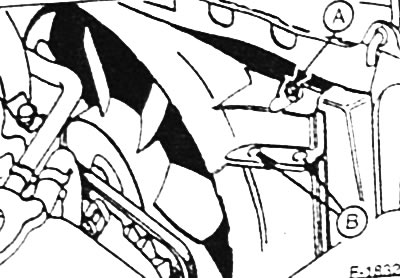Withdrawal
After a long vehicle run, narrow channels in the radiator may become clogged with coolant deposits and salt deposits. As a result, the performance of the radiator drops and the engine overheats. In this case, only replacing the radiator can help.
Disconnect ground wire (-) battery.
Caution: Disconnecting the battery will erase the contents of the electronic memories, such as engine trouble codes or radio codes. Before switching off, also read the instructions in chapter "Removing and installing the battery".
Drain coolant.

Disconnect the upper and lower coolant hoses -B- and the hose leading to the expansion tank from the radiator. First completely release and slide back the fastening clamps.
If present, loosen the clamp and disconnect the hose -A- from the radiator to the expansion tank.

ONS and V6 engines. Unscrew the fixing bolts -A- of the upper air duct, separate the air duct from the clamps -B- and remove. Loosen the mounting bolts and remove the lower air duct.
DOHC engine: remove the fan, see p. 41.
Diesel engine: remove the air duct and disconnect the plug connection of the temperature sensor.
Vehicle with air conditioning system: Disconnect the plug connection of the air conditioning temperature sensor.

Vehicle with automatic transmission: Place a clean container underneath to drain the transmission oil. Loosen the fastening of the connecting pipelines of the gearbox oil cooler at the lower radiator tank. To prevent too much oil from flowing out, plug the pipelines with suitable plugs.

Pull the clips out of the radiator holders.

Unscrew the 2 mounting bolts -D- from below and pull them out together with washers -C-, spacers -B- and rubber buffers -A-.
Remove radiator towards bottom.
Attention: The fins of the radiator tubes are very sharp, so wear gloves when removing the radiator.
Attention: If the radiator is not to be installed within 48 hours, it must be flushed with clean water, blown with compressed air and all openings must be closed. The radiator can also be filled with coolant and stored with the holes closed. If this is not done, rust will form, which can later cause leaks.
Installation
If a new radiator is being installed, the temperature sensor and air duct clamps should be replaced on it.
If a used radiator is installed, it must first be checked. Check for leaks and damage to the tanks and radiator tubes. Bent fins must be carefully straightened with a screwdriver.
Check all coolant hoses for cuts, cracks or other damage and replace if necessary. Check the condition of the rubber inserts of the radiator holders.
Insert the radiator from below and insert the fastening clips into the holders through the front facing.
Tighten lower radiator mounting bolts to 10 Nm. Ensure the correct position of the rubber buffers, see figure S/24/16.
Attach the air ducts and tighten the fastener to 10 Nm.
DONS engine: install fan, see p. 41.
Vehicle with air conditioning system: connect the plug connector of the air conditioning temperature sensor.
Diesel engine: Connect the temperature sensor plug.
Vehicle with automatic transmission: remove the plugs from the pipes and screw the pipes to the oil cooler. Check the oil level in the automatic transmission, see p. 205.
Connect the upper and lower coolant hoses and secure with clamps.
Connect the coolant hose to the expansion tank and secure it with a clamp.
Fill in coolant see p. 38.
Warm up the engine and check the hose connections and the radiator for leaks.
Check and top up the coolant level if necessary.
Visitor comments